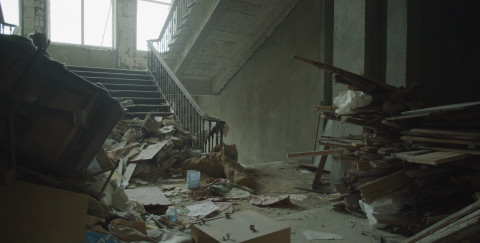Ghent-based artist Nikolai Karabinovytch has created a varied body of work that translates marginalized histories into a contemporary artistic vocabulary. He often explores his Jewish, Greek, and Ukrainian roots through personal and collective histories, illuminating the ways in which they are intertwined. For instance, pieces that trace the journeys of Karabinovytch’s great grandfather and great grandmother address global experiences of displacement through forced migration and deportation. In other works, he also examines concerns of nationalism, authoritarianism, and the power of propaganda, using a range of media—sculpture, painting, performance, and video.
Karabinovytch explains, “It all depends on the story, the context, the factors…. It is not necessary to know at the outset what the end form will be. Much more crucial is the experience of the visitor—what experience they will have.” In many instances, music also becomes a critical medium. Karabinovytch sees music as a universal language. It does not need translation like written text or spoken words and generates sensations that are difficult to create with other media. Therefore, it is an accessible and effective conduit for entering and understanding the narratives that shape Karabinovytch’s art.
At times, the artist has performed as a DJ under the pseudonym DJ Albert Heijn—a name taken from a supermarket chain in Belgium and The Netherlands—to confront the right-wing references in the rave scene. As the DJ, Karabinovytch aims to “test various cliches in electronic music and try to decolonize them.” For the action Afterhours (2018) he wrote accounts of post-Soviet attacks and police raids on raves and techno parties in chalk on a dance floor. When the space opened to dancers, the footwork from their gestures and movements wiped away the text. Through party and pleasure, rather than the violence inflicted on dancers in the past, Afterhours confronts and powerfully protests histories of repression by literally and figuratively rubbing them out.
The medium of video serves Karabinovytch’s purposes to great effect in Something Happened this Spring (2021). Its retelling of history conveys the unfolding nature of events. Karabinovytch was able to represent the temporality of an experience as well as visually and sonically impress upon the viewer senses of danger and ominousness. Something Happened begins with the camera slowly tracking through an overcast sky to the House of Trades Union building in central Odessa, Ukraine. A sinister droning dirge accompanies the view, which hovers over the building as smoke faintly emits from its upper floor windows. The camera then cuts to the interior and continues its search through the stairwell, where piles of wood and debris litter the floor and staircase. The final sequence takes place in the empty auditorium, where a cloud of smoke slowly rises from the middle of the room. The plume expands above the seats, as the camera slowly moves down the center aisle, into the cloud and toward the rear doors. However, the video ends before exiting out the back, leaving the viewer in a heightened state of suspension without release or resolution, echoing the inconclusiveness of the video’s title.
Something Happened this Spring is an elegiac ode to May 2, 2014, when violence erupted in Odessa. Pro-Russian activists attacked a march for Ukrainian unity and independence, and both groups took up arms, including guns, stones, and Molotov cocktails. The pro-Russian protestors entered the Trades Union building, where a fire broke out on the third floor, killing more than forty people. Despite the loss and devastation, the Ukrainian government failed to fully investigate what caused the fire. Both sides accused the police of protecting the other, and because of the lack of certainty or conclusive information the event became fodder for propaganda and conspiracy theories. The building remains in disuse and serves as a reminder of not only what has been lost—lives and history—but also the silencing of officials. Karabinovytch recalls that the aftermath in Odessa led to the “formation of a specific local culture of non-remembrance, a kind of ‘monument of silence’ at the scene of the fire.”
The disuse of the building further evokes an unwillingness or inability to repair relations or resolve disputes between Ukraine and Russia, which has grown larger and become more devastating. Indeed, the Trades Union fire figures as foreshadowing of the current war between the countries. However, the video is more poetic than directly political. Karabinovych refrains from taking sides in the matter. The haziness of Something Happened, suggests the impossibility of doing so, as it evokes the larger politics of memory that have plagued the region. – Kanitra Fletcher

